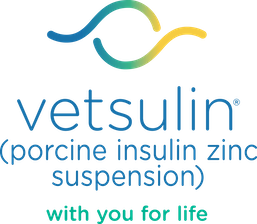

Nutrition for Cats With Diabetes
Read More About Monitoring & Controlling Feline Diabetes
Helping Maintain Glycemic Control
Insulin therapy provides the mainstay of management for most patients, but management of other factors such as diet and exercise can influence glycemic control.
Dietary Control
A cat with diabetes needs a diet that provides for all nutritional needs and should minimize postprandial fluctuation in glucose concentrations. An ideal diet should be:
- Consistent from day to day to prevent unnecessary changes in insulin requirements
- Fat-restricted
- Contain a high-quality, highly digestible protein source (eg, eggs or meat rather than soybean or corn gluten meal)
- Of the correct caloric value to help the pet achieve optimal body weight
- Low in carbohydrates
- Cats are obligate carnivores and naturally require a high-protein diet.
- Though diet needs to be tailored to a cat’s individual needs, high-protein, low-carbohydrate foods are ideal for many cats with diabetes. (Typically a diet with less than 10% total calories as carbohydrates.)
- If feeding dry food, ideally a prescription diet formulated for cats with diabetes should be fed. There are many non-prescription, canned cat foods that can be utilized in cats with diabetes.
A number of prescription diets have been specially formulated for patients with diabetes. These can help obese patients lose weight. However, most cats with diabetes can be stabilized on a carefully controlled program using their normal diet. Stabilization on a non-prescription diet is much easier if a complete, moist food is fed.
Clean drinking water should be available at all times. A reduction in excessive water consumption indicates successful management of diabetes mellitus.
Importance of an Ideal Body Weight
In cats that are underweight or overweight, pursue respective weight gain or loss to help the pet achieve its ideal body weight.
In underweight cats, avoid calorie-dense diets, especially those that are high in soluble carbohydrates.
Obesity contributes to insulin resistance. Overweight cats should lose weight in a gradual, controlled fashion. Weight loss in obese animals decreases the insulin requirement.
The following pet food companies produce balanced diets formulated for cats with diabetes. For more information, click on each company name to reach its website.
For specific information about dietary control, see the cat’s Feeding Schedule.
Resources to Help Clients Monitor Care
Help Your Practice Manage Diabetes Mellitus
Check out these tools and resources to help manage feline diabetes.

Blood Glucose Curve Generator
Create a blood glucose curve to monitor and evaluate diabetes treatments.

Client Discharge Form
Create a customized, printable form for clients about their new diagnosis.

Diabetes Resources
Access online tools and more to support staff and pet parents.
No items to show.
Read More About Monitoring & Controlling Feline Diabetes
Important Safety Information:
Vetsulin® should not be used in dogs known to have a systemic allergy to pork or pork products. Vetsulin is contraindicated during periods of hypoglycemia. Keep out of reach of children. As with all insulin products, careful patient monitoring for hypoglycemia and hyperglycemia is essential to attain and maintain adequate glycemic control and prevent associated complications. Overdosage can result in profound hypoglycemia and death. The safety and effectiveness of Vetsulin in puppies, breeding, pregnant, and lactating dogs has not been evaluated. See package insert for full information regarding contraindications, warnings, and precautions.
References:
1. Martin GJ, Rand JS. Pharmacology of a 40 IU/ml porcine lente insulin preparation in diabetic cats: findings during the first week and after 5 or 9 weeks of therapy. J Feline Med Surg. 2001;3(1):23–30. 2. Vetsulin® (porcine insulin zinc suspension) [Freedom of Information Summary]. Millsboro, DE: Intervet Inc.; 2008. 3. Data on file, Merck Animal Health. 4. Graham PA, Nash AS, McKellar QA. Pharmacokinetics of porcine insulin zinc suspension in diabetic dogs. J Small Anim Pract. 1997;38(10):434–438. 5. Martin GJ, Rand JS. Pharmacokinetic and Pharmacodynamic Study of Caninsulin in Cats with Diabetes Mellitus. 2000: Internal Study Report. 6. Feldman EC, Nelson RW. Canine and Feline Endocrinology and Reproduction. 3rd ed. St. Louis, MO: Saunders; 2004:539–579. 7. Tennant B, ed. BSAVA Small Animal Formulary. 4th ed. Gloucestershire, UK: British Small Animal Veterinary Association; 2002. 8. Feldman EC, Nelson RW. Canine and Feline Endocrinology and Reproduction. 3rd ed. St. Louis, MO: Saunders; 2004:486–538. 9. Reusch C. Feline diabetes mellitus. In: Ettinger SJ, Feldman EC, eds. Textbook of Veterinary Internal Medicine. 7th ed. St. Louis, MO: Saunders; 2010:1796–1816. 10. Nelson RW. Canine diabetes mellitus. In: Ettinger SJ, Feldman EC, eds. Textbook of Veterinary Internal Medicine. 7th ed. St. Louis, MO: Saunders; 2010:1782–1796. 11. Burgaud S, Riant S, Piau N. Comparative laboratory evaluation of dose delivery using a veterinary insulin pen. In: Proceedings of the WSAVA/FECAVA/BSAVA congress; 12–15 April 2012; Birmingham, UK. Abstract 121. 12. Burgaud S, Guillot R, Harnois-Milon G. Clinical evaluation of a veterinary insulin pen in diabetic dogs. In: Proceedings of the WSAVA/ FECAVA/BSAVA congress; 12–15 April 2012; Birmingham, UK. Abstract 122. 13. Burgaud S, Guillot R, Harnois-Milon G. Clinical evaluation of a veterinary insulin pen in diabetic cats. In: Proceedings of the WSAVA/FECAVA/BSAVA congress; 12–15 April 2012; Birmingham, UK. Abstract 45. 14. Davison LJ, Walding B, Herrtage ME, Catchpole B. Anti-insulin antibodies in diabetic dogs before and after treatment with different insulin preparations. J Vet Intern Med. 2008;22:1317-1325. 15. Banfield State of Pet Health 2016 Report. p 12-13.
